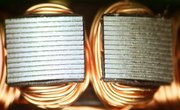
Natural magnets are different from other magnets, because they do not need to have their properties altered in order to become magnetized. Some materials may become temporarily or permanently magnetized when rubbed by magnets, or when they are subjected to electric fields. Natural magnets are already magnetic and are found in the Earth.
Types
One example of a natural magnet is the mineral magnetite, composed of an iron oxide. A lodestone is a type of magnetite that was one of the earliest natural magnets discovered. Basalt, which forms when lava hardens, also contains magnetite, although its magnetic field is weak.
Another natural magnet is pyrrhotite, which is formed of iron sulfide. It is only weakly magnetic, with the strength of its field varying according to the amount of iron contained.
The Earth itself behaves as a natural magnet. It has a magnetic south pole which is actually located geographically north, in Canada. Likewise, its magnetic north pole is actually geographically south, in the Antarctic.
Magnetic Theory
Magnetism is created from moving charges, or electric current. The moving charges both create and respond to magnetic fields. An atom has electrons that revolve around the nucleus and also rotate on their axes in a manner called spin. These movements give rise to magnetic fields.
Behavior
Like all magnets, natural ones attract or repel other magnets, as well as other materials such as iron and steel. The places on the magnet that produce opposite magnetic forces are called north and south poles. North poles always attract south poles, and vice-versa. However, north poles brought near other north poles (and south poles brought near other south poles) repel each other.
Ferro- and Ferrimagnetism
Natural magnets are known as permanent magnets. The continual magnetism of permanent magnets is due to the presence of magnetic dipoles in magnetic domains. A dipole is positive charge and a negative charge that have the same size and are a certain distance from each other. A magnetic dipole has two poles, north and south, that are spaced apart. A bar magnet is therefore considered to be a magnetic dipole, and so is the Earth. A solitary atom can also be a dipole. Magnetic domains are formed from dipoles that are mainly aligned in the same direction.
Permanent magnets may be ferromagnetic or ferrimagnetic. Ferromagnets are permanent because they have many magnetic domains, where each one behaves like a tiny magnet. Ferrimagnets are similar to ferromagnets, except their domains are aligned differently. Magnetite and certain forms of pyrrhotite are ferrimagnetic.
Significance
Bar, horseshoe, disk and some refrigerator magnets may be made from natural magnets. The black sand on beaches is usually formed from magnetite. The Chinese invented the compass, which was made using lodestone. Chinese fortunetellers first used compasses for divination; sailors eventually used them for navigation.
References
- "Fundamentals of Physics Extended"; David Halliday, Robert Resnick, Jearl Walker; 2010
- "Geology Magills’ Choice"; edited by James A. Woodhead; 1999
- “Introduction to Mineral Sciences”; Andrew Putnis; 1992
- “Magnet Science”; Glen Vecchione; 1998
About the Author
Kim Lewis is a professional programmer and web developer. She has been a technical writer for more than 10 years and has written articles for businesses and the federal government. Lewis holds a Bachelor of Science, and occasionally teaches classes on how to program for the Internet.
Photo Credits
paper-clips image by Ivonne Wierink from Fotolia.com
